Hiking with your kids is a fantastic way to enjoy nature while boosting their physical health and emotional well-being. Choose trails suited to their skill levels, prepare with essentials like water and snacks, and engage them with fun activities like scavenger hunts or storytelling. After your adventure, discuss the day’s experiences and create nature journals to cherish the memories. There’s so much more to explore about fostering a love for the outdoors in your children.
Key Takeaways
- Choose age-appropriate trails, ideally one mile per year of a child’s age, ensuring safety and enjoyment for everyone involved.
- Pack essential supplies like water, healthy snacks, and a first aid kit to ensure a comfortable hiking experience.
- Engage kids with activities like scavenger hunts and storytelling to enhance their learning and keep their interest alive during the hike.
- Reflect on the hiking experience afterward, encouraging kids to share their thoughts and create a nature journal to document their adventures.
- Incorporate environmental education by teaching kids about local wildlife and sustainability, fostering a sense of stewardship for nature.
Benefits of Hiking With Kids
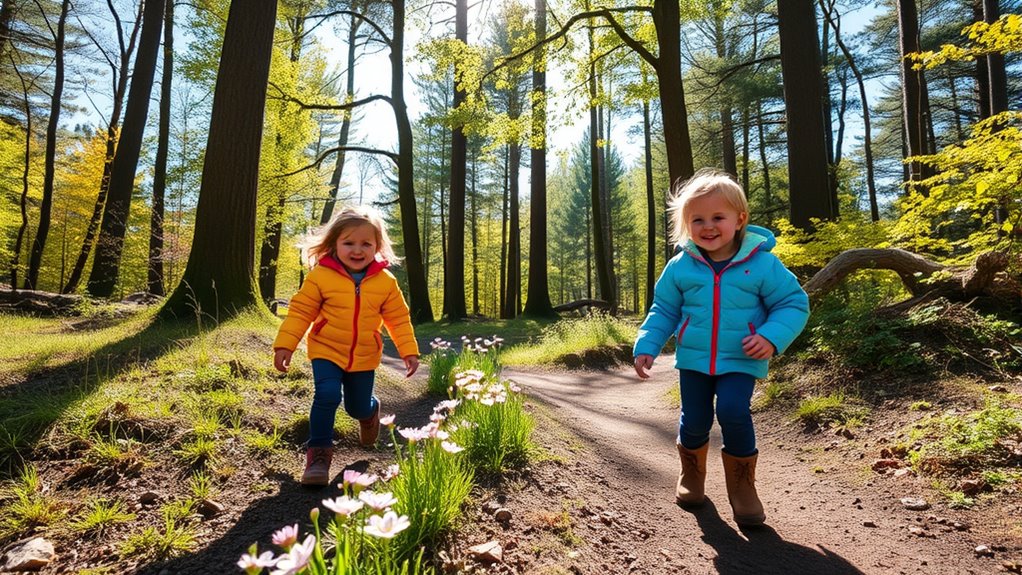
Hiking with kids offers countless benefits that extend beyond just fun and adventure. It’s a fantastic way to boost their physical health, engaging various muscle groups while improving cardiovascular fitness. Regular hikes help maintain a healthy weight and strengthen their endurance. As they navigate through diverse terrains, their balance and coordination improve, too.
Cognitively, nature stimulates curiosity and enhances problem-solving skills. Kids learn about plants, animals, and geology, which enriches their understanding of the world.
Emotionally, the calmness of nature reduces stress and anxiety, boosting their mood and self-esteem. Hiking fosters social interaction, teamwork, and a sense of accomplishment, strengthening family bonds.
Choosing the Right Trails

When planning an outdoor adventure with kids, choosing the right trails can make all the difference in ensuring a fun and memorable experience.
Start by evaluating your children’s skill levels and ages; opt for short, flat trails for the youngest ones. A good rule is one mile for each year of age. Engaging in creative practice during breaks can enhance their connection to nature and foster imaginative thinking. Additionally, consider incorporating camping essentials like portable snacks to keep their energy levels up during hikes.
Evaluate your children’s skill levels and choose short, flat trails—aim for one mile per year of age.
Prioritize well-marked, maintained trails to keep everyone safe and engaged. Look for trails with natural features, wildlife viewing, or educational signs to captivate their interest.
Consider the terrain—aim for easy to moderate paths with gentle slopes and minimal elevation changes.
Finally, choose pleasant weather and plan for breaks, allowing time for hydration and exploration.
Incorporating nearby locations with unique camping experiences can enhance your family’s outdoor adventure.
With the right trail, you’ll create lasting memories together.
Preparing for the Hike
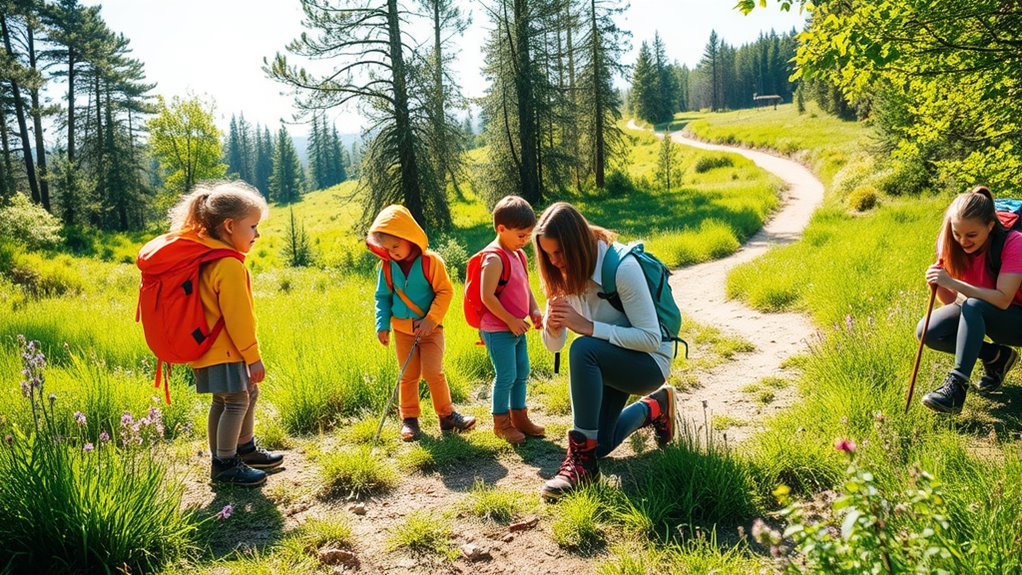
After choosing the perfect trail, it’s time to get ready for the hike. Start by packing enough water to keep everyone hydrated and include healthy snacks like nuts and granola bars. Dress in layers and wear comfortable, waterproof shoes. Don’t forget sun protection—bring sunscreen, hats, and sunglasses. Use a sturdy backpack to carry essentials.
Safety is key; pack a first aid kit, navigation tools, and flashlights for late returns. Add insect repellent and emergency gear like a whistle or pocketknife.
Teach kids to respect wildlife and practice “Leave No Trace” principles. Bring extra clothes, communication devices, and comfort items. Finally, inform someone about your plans and expected return time to guarantee a safe adventure.
Engaging Kids During the Hike
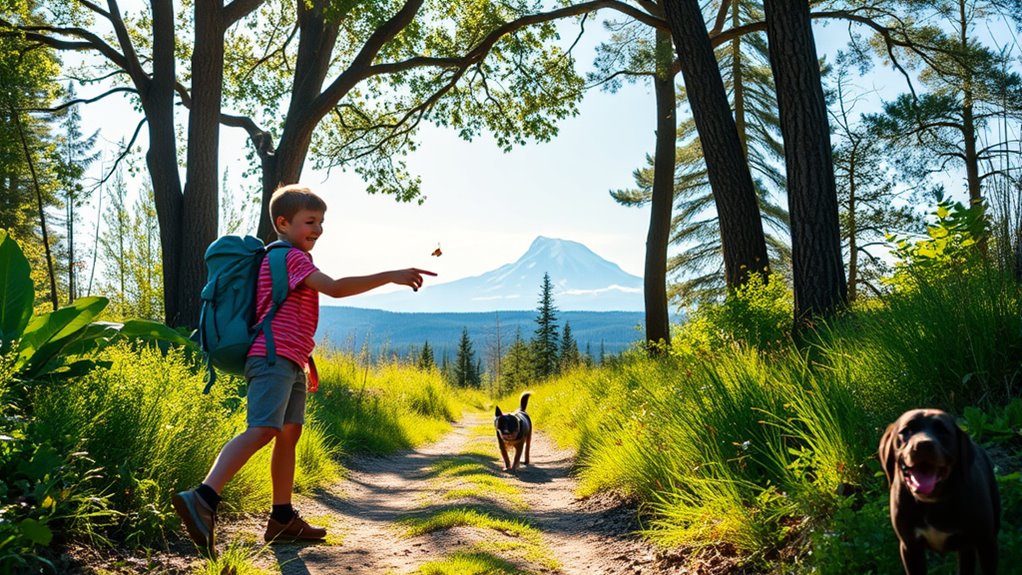
To keep kids engaged during your hike, consider incorporating fun activities that spark their curiosity and excitement about nature.
Create a nature scavenger hunt with a checklist of items suited to their ages, from simple colors for younger kids to animal tracks for older ones. Encourage them to describe sounds, smells, and textures they encounter, deepening their connection to the environment.
Introduce storytelling by allowing kids to contribute to an evolving tale inspired by their surroundings. You can also teach basic navigation skills or discuss local wildlife, turning the hike into an educational experience.
Finally, make it playful with classic games like “I Spy” to keep their energy up and foster interaction.
Fun Activities on the Trail
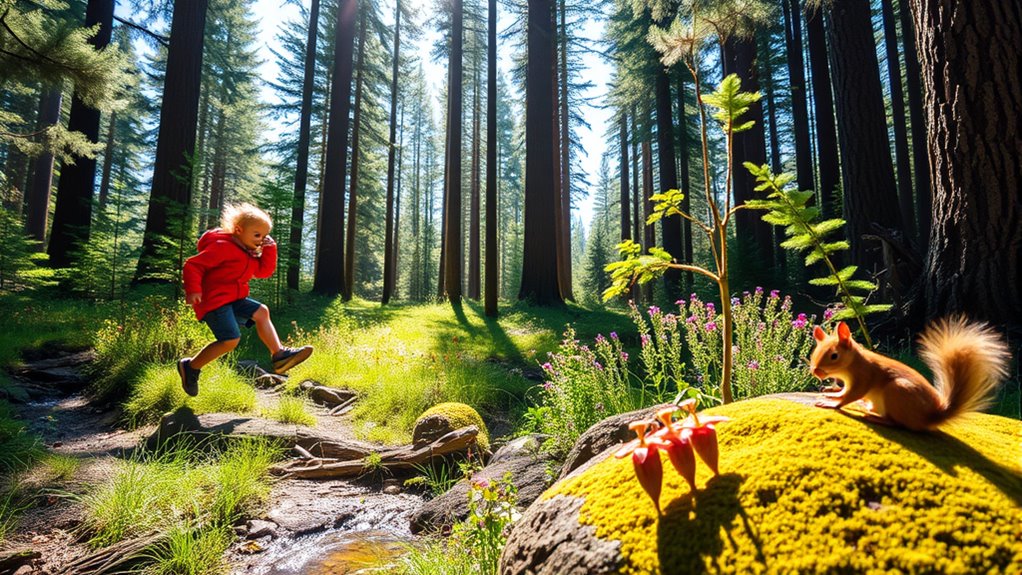
While exploring the great outdoors with your kids, incorporating fun activities on the trail can transform a simple hike into an unforgettable adventure.
Start a nature scavenger hunt by giving them a list of items like leaves or rocks to find. Try a color scavenger hunt to see who spots a red leaf or blue bird first. Engage them with animal quizzes, identifying sounds or guessing diets. Additionally, consider bringing along educational toys that promote sensory experiences and enhance their connection to nature. Establishing a connection with nature can help foster trust issues in relationships, as it encourages open communication and bonding.
Roving hide-and-seek keeps everyone moving, while nature drawings encourage creativity. Organize an alphabet hunt or create an obstacle course with natural features. Finally, don’t forget to teach them about local wildlife and ecosystems, making your hike both fun and educational! Additionally, consider integrating strategies for effective co-parenting communication to ensure that both parents are on the same page during outdoor adventures.
Post-Hike Reflections
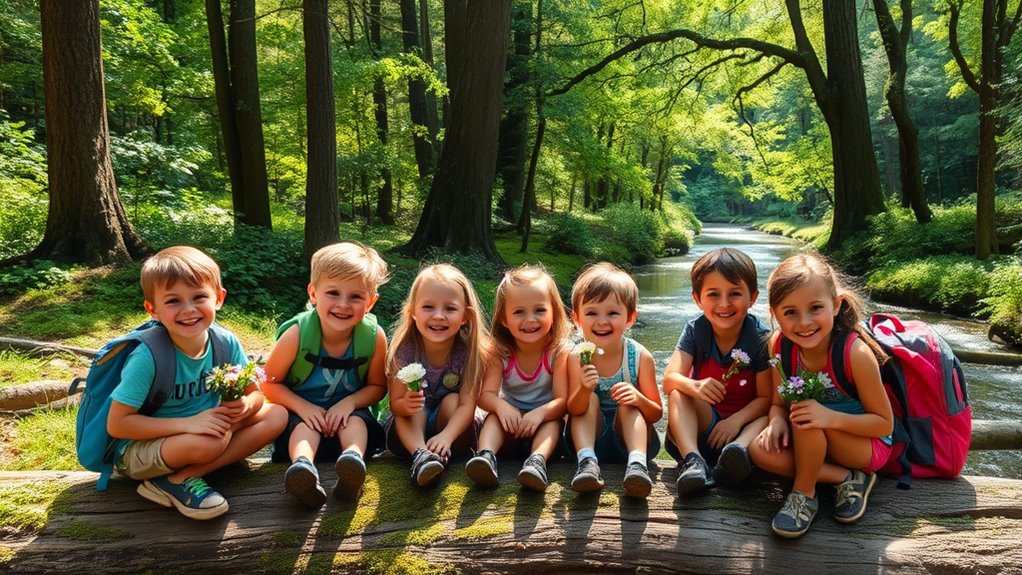
Engaging in post-hike reflections can greatly enhance the overall experience of your outdoor adventures with kids. This practice encourages your children to articulate their experiences, boosting their verbal skills and emotional processing. Discussing what they learned about nature fosters critical thinking and curiosity. You can create a nature journal or a scrapbook of photos to reinforce memories, making the adventure more vivid. Additionally, sharing experiences about the importance of work-life balance can provide insight into how outdoor activities can help manage stress and improve overall well-being. Incorporating discussions about stress management techniques can also help children understand the value of planning for the future. Sharing favorite moments strengthens family bonds and builds emotional intelligence. By celebrating achievements, you boost their self-esteem while promoting mindfulness. Plus, these reflections set the stage for future hikes, allowing for goal-setting and planning. Engaging in this reflective process truly enriches their outdoor experiences, paving the way for a love of nature. Additionally, creating a safe and comfortable outdoor space can enhance their enjoyment and engagement with nature, promoting a better senior living experience.
Tips for a Successful Family Hiking Experience

Planning a successful family hiking experience starts with thoughtful preparation. Choose trails with exciting destinations like waterfalls or lakes to motivate your kids. Research trail conditions, mileage, and the best times to visit to guarantee a smooth hike.
Involve your children in planning to boost their interest. Equip them with kid-friendly gear, like backpacks and water bottles, to enhance their experience.
Keep safety in mind by checking weather forecasts and educating kids on trail safety. Carry plenty of high-energy snacks and water to keep everyone energized and hydrated.
Remember to let your children set the pace, take frequent breaks, and maintain a positive attitude. Flexibility is key; adapt your plans based on their needs and the day’s circumstances.
Encouraging a Love for Nature in Children
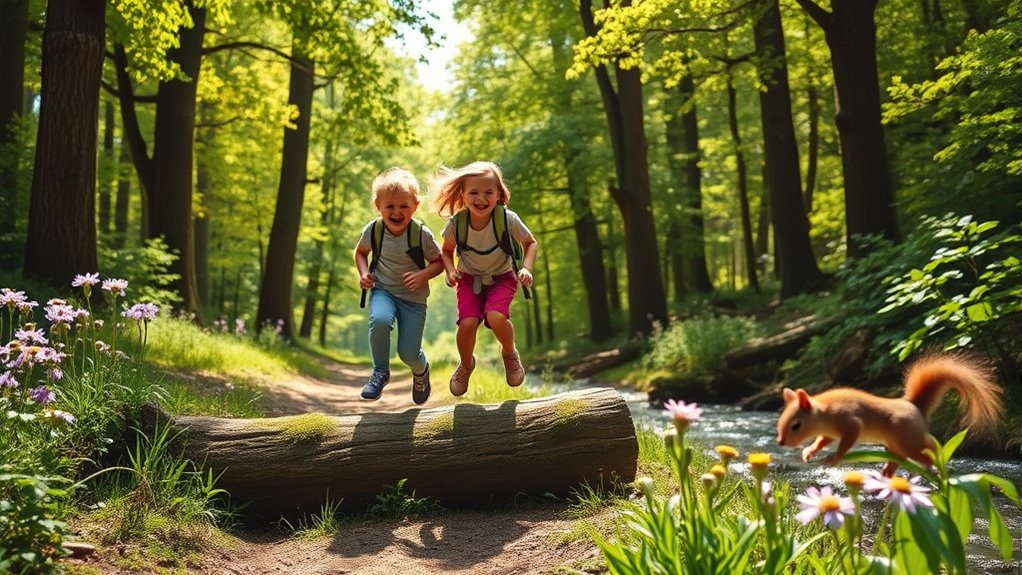
After a successful hiking experience, the next step is to nurture your child’s love for nature. Encourage outdoor play and exploration; even five minutes outside can boost cognitive function and creativity. Spending time in nature can also enhance mental health and well-being, making it an ideal setting for children to thrive. Engaging with nature can lead to improved immune system function, allowing children to stay healthy while exploring the great outdoors.
Engage them in nature-based activities like gardening or nature walks, which not only enhance focus but also reduce stress and anxiety. Make it a family affair—participating in outdoor activities together strengthens bonds and promotes social skills.
Teach them about local plants and animals to inspire environmental awareness and responsibility. By fostering these connections, you’ll help your child develop a lifelong appreciation for nature, nurturing their emotional well-being, cognitive growth, and physical health while instilling a sense of stewardship for our planet. Additionally, incorporating digital literacy programs can enhance their understanding of the environment through interactive learning experiences.
Frequently Asked Questions
What Age Is Appropriate for Kids to Start Hiking?
You can start introducing your kids to hiking as early as a couple of months old, but it’s best to wait until they’re at least one to two months for safety.
Infants are usually carried, while toddlers can walk short distances but may tire quickly.
As your child grows, around ages 3-4, they can handle about 1.5 km, and older kids can manage longer hikes.
Always consider their physical abilities and personalities when planning.
How Can I Ensure My Child’s Safety on the Trail?
So, you think your little explorer’s ready to tackle the wild? Great! To guarantee their safety on the trail, start by choosing kid-friendly paths.
Pack essentials together, and don’t forget a safety whistle—because yelling “help!” isn’t the best plan. Regular breaks keep spirits high, and a well-stocked first aid kit is a must.
Finally, remind them to stay on the trail unless they’re auditioning for a nature documentary!
What Should I Do if My Child Gets Tired During the Hike?
If your child gets tired during the hike, first, assess their comfort level and adjust your pace.
Take regular breaks to let them rest and recharge. Offer snacks and water to keep their energy up.
Engage them with games or storytelling to distract from fatigue. If they’re still struggling, consider shortening the hike or turning back.
Are There Any Hiking Apps for Families?
Yes, there are several hiking apps designed specifically for families.
Apps like TrailCollectiv and AllTrails offer kid-friendly trails with essential information, such as restroom locations and difficulty levels.
Hiking Project provides detailed descriptions and offline maps, while Komoot lets you create custom trails.
These apps keep you informed about trail conditions and engage your kids with educational features, making your outdoor experiences more enjoyable and interactive.
How Can I Encourage Reluctant Kids to Hike?
To encourage reluctant kids to hike, start by making the experience feel like a thrilling adventure.
Let them choose the trail based on their interests, like a lake or wildlife. Use descriptive language that highlights the excitement of exploration.
Introduce fun activities like scavenger hunts or games along the way, and offer small rewards for reaching goals.
Celebrate their achievements, and make sure to include plenty of breaks for snacks and play.
Conclusion
In the end, hiking with your kids isn’t just about reaching the summit; it’s about the memories you create along the way. Each step taken together plants seeds of curiosity and a love for nature that’ll last a lifetime. So, lace up those hiking boots, pack some snacks, and get ready for an adventure! After all, the great outdoors is waiting to share its wonders with your family—will you answer the call?









